The Chadwick Plush Company was operating under the specter of a strike in 1899. Behind the scenes, a new corporation, the Holyoke Plush Company, was formed. This may have been a reaction to the strikers' demands or an opportunity for the company owners to earn a return on their investments.
Local shareholders sold their interests to Maine and Boston operatives. E. M. Goodall of Sanford, Maine, was president, Frank Hopewell of Boston was treasurer, and locally, Day Chadwick served as the operating manager.
The company manufactured plush lap robes, velours, carriage robes, carpet yarn (1920s), and other woolen products.
The company continued to operate in the Cabot Mills. In 1903, the winds were swirling, and a new company, the Crocker-McElwain Paper Company, would purchase the building for its use.
On March 2, 1903, Holyoke Plush Company and Whitmore Company were served notice that their leases would expire in April. As a sign of goodwill, the companies would be allowed to remain until August 1. The Whitmore Company had plans to build a new three-story mill on the third level of the canal opposite Deane Steam Pump.
On March 20, 1903, Day and John Chadwick, representing the Holyoke Plush Company, purchased the former New York Mill from the Holyoke Water Power Company at the northwest corner of Main and South Street. The address was 649 Main Street. The mill was last used by Connor Brothers Woolens until that business failed in 1901.
The Chadwicks had investigated other locational opportunities in Willimansett and at the former Glasgow Mill in South Hadley Falls, but chose to remain in Holyoke.
In September 1903, ownership passed to the Holyoke Plush Company for $60,000. The complex measured 175' along Main Street and 316' up South Street. The company was also building a 30'x100' dye house on the site.
On January 14, 1904, the machinery was tested, and production began the following day. The new plant had 50% more capacity than the former, with room for expansion.
On November 24, 1909, John Chadwick died of injuries sustained in a motor vehicle crash a week earlier on Springfield Road. Also killed in the collision was Max Otto Dreikorn. This was the first in a sequence of calamitous events that impacted families and the business.
James E. Jagger, who was employed with the company since a very young age, was named by Day Chadwick to replace the late John Chadwick.
In 1912, the Casper Ranger Company was awarded the contract to build a $4,000 addition on the Main Street side of the mill.
In 1913, Sam Jagger, foreman of the Holyoke Plush Company and father of James E. Jagger, died.
In 1914, the Holyoke Plush Company purchased some of the equipment of the recently failed neighboring Beebe-Webber Company.
In 1916, Day Chadwick, age 76, died. His longtime home was at the corner of Beech Street and the former Chase Avenue. He and John Chadwick held onto many trade secrets in the field of producing velour. Also in 1916, E. M. Goddard threatened to close the Holyoke mill and relocate it to Maine, due to ongoing labor issues. A negotiated compromise between the mill and the Fireman's Union was agreed to three days later on November 3, 1916.
On January 4, 1917, James E. Jagger was elevated to Director of the corporation. He had been the Superintendent of the plant and was a 21-year employee. Six months later, on July 7, 1917, he and his four-year-old daughter were killed when their car stalled on the tracks after leaving the Holyoke Canoe Club. He had gone back to the car to rescue his daughter when a B&M train struck them. His wife and two other children managed to reach safety.
The cloud continued to overhang the Holyoke Plush Company in 1919. Ernest M Goodall, the company president, died while at his winter home in Florida. He was president of Holyoke Plush Company, Sanford (Maine) Mills, the Sanford Trust Company, Sanford Water Company, Goodall Worsted Mills, and other businesses and corporations. He was an influential member and contributor to his community. All stores and factories in Sanford, Maine, shut down during the hours of his service. In the same year, Stephen J. Goyette, the thirteen-year master mechanic and engineer of the business, died.
In 1923, financial problems hampered the company's ability to operate. The following year, the company filed for bankruptcy, listing liabilities of over $305,000 with about $165,000 in assets. On April 24, 1925, the company's real estate, equipment, and other assets were totally liquidated at public auction. Charles Belsky & Company purchased the real estate at the auction for $77,500.
Fourteen years later, on November 20, 1939, a major fire destroyed much of the factory site.
Citations:
Newspapers.com (paid subscription): Citations: Holyoke (Massachusetts) Transcript & Transcript-Telegram; publication dates and pages are shown.
Holyoke Public Library History Room, Price & Lee City Directories, Holyoke, Massachusetts.
Sanborn Fire Insurance Map of Holyoke, Massachusetts, 1915






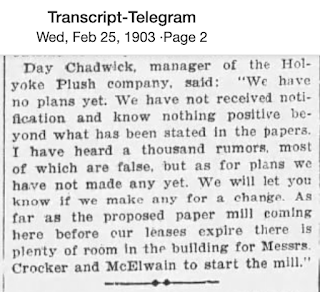







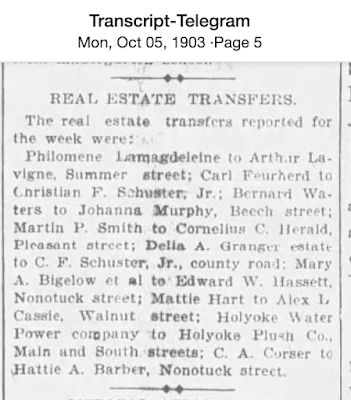






















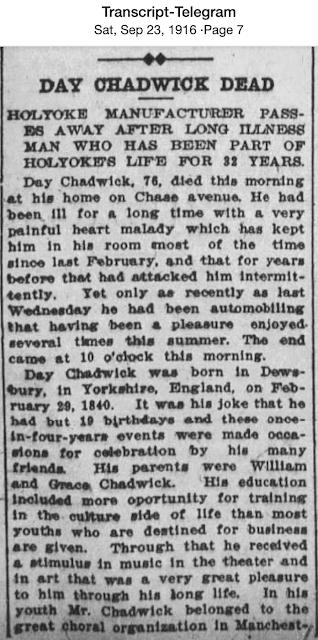

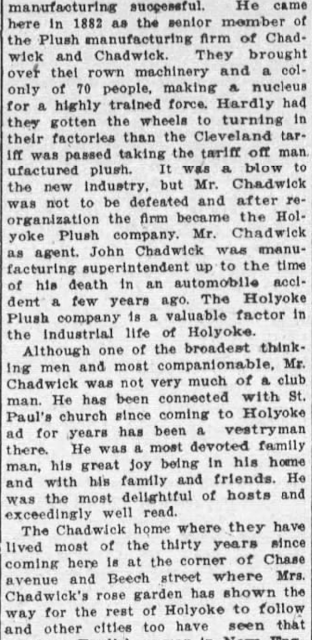





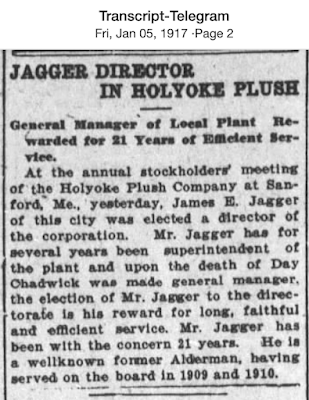






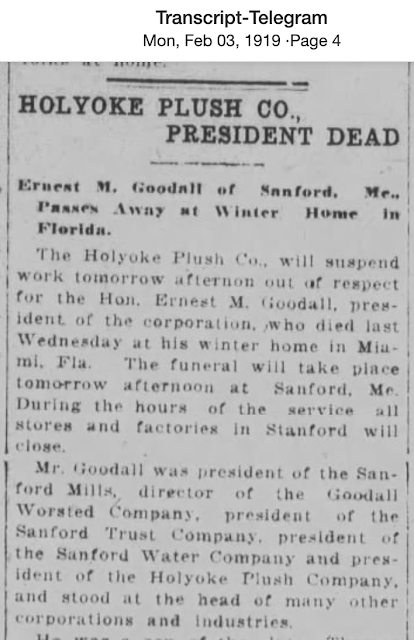















No comments:
Post a Comment